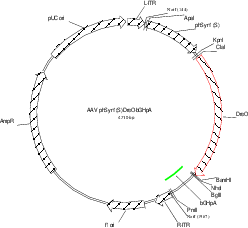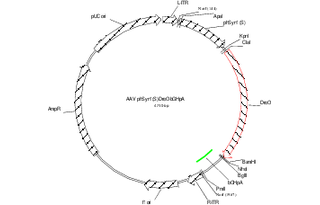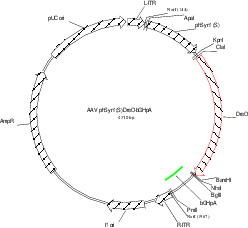-
PurposeCan be used to generate AAV virus that will express DreO recombinase in neurons from the synapsin promoter
-
Depositing Lab
-
Sequence Information
Ordering
| Item | Catalog # | Description | Quantity | Price (USD) | |
|---|---|---|---|---|---|
| Plasmid | 50363 | Standard format: Plasmid sent in bacteria as agar stab | 1 | $89 | |
| AAV5 | 50363-AAV5 | Virus (100 µL at titer ≥ 1×10¹³ vg/mL) and Plasmid. | $437 | ||
| AAV Retrograde | 50363-AAVrg | Virus (100 µL at titer ≥ 7×10¹² vg/mL) and Plasmid. | $437 | ||

Don’t see the serotype you want?
Make a packaging request and we'll get back to you.
Please log in to submit a packaging request.
-
SerotypeSelect serotype for details See details about
-
PricingSelect serotype and quantity $ USD for preparation of µL virus + $32 USD for plasmid.
-
How this works
- Place a request for a quantity of 2 (0.2 mL), 10 (1 mL), 25 (2.5 mL), or 50 (5 mL). Our all-inclusive pricing includes DNA production and QC.
- Addgene will quickly confirm that we can produce a high-quality prep for you.
- Track your request and place an order from within your account. Payment information must be added before we can begin processing your order.
- Receive your prep in 6–9 weeks after the MTA is approved by your organization.
- Learn more about our Packaged on Request Service.
Backbone
-
Vector backbonepAAV-MCS
-
Backbone manufacturerStratagene
- Total vector size (bp) 4710
-
Modifications to backboneA fragment containing the hSyn1 promoter-DreO recombinase gene-bGHpA were swapped in to replace the CMV promoter-MCS-hGHpA sequence. Total insert size including the two ITRs is 2113 bp.
-
Vector typeAAV
Growth in Bacteria
-
Bacterial Resistance(s)Ampicillin, 100 μg/mL
-
Growth Temperature30°C
-
Growth Strain(s)Stbl2
-
Copy numberUnknown
Gene/Insert
-
Gene/Insert nameDreO recombinase
-
Alt nameDre
-
SpeciesPhage
-
Insert Size (bp)1050
-
MutationSequence optimized for expression in mammalian cells
- Promoter hSyn1
-
Tag
/ Fusion Protein
- none
Cloning Information
- Cloning method Restriction Enzyme
- 5′ cloning site Not1 (not destroyed)
- 3′ cloning site Not1 (not destroyed)
- 5′ sequencing primer none
- 3′ sequencing primer none (Common Sequencing Primers)
Resource Information
-
Articles Citing this Plasmid
Terms and Licenses
-
Academic/Nonprofit Terms
-
Industry Terms
- Not Available to Industry
Trademarks:
- Zeocin® is an InvivoGen trademark.
Information for AAV5 (Catalog # 50363-AAV5) ( Back to top)
Purpose
Ready-to-use AAV5 particles produced from AAV phSyn1(S)-DreO-bGHpA (#50363). In addition to the viral particles, you will also receive purified AAV phSyn1(S)-DreO-bGHpA plasmid DNA.
hSyn-driven Dre recombinase expression. These AAV preparations are suitable purity for injection into animals.Delivery
- Volume 100 µL
- Titer ≥ 1×10¹³ vg/mL
- Pricing $405 USD for preparation of 100 µL virus + $32 USD for plasmid.
- Storage Store at -80℃. Thaw just before use and keep on ice.
- Shipment Viral particles are shipped frozen on dry ice. Plasmid DNA (≥ 200ng) will also be included in the shipment.
Viral Production & Use
- Packaging Plasmids encode adenoviral helper sequences and AAV rep gene, AAV5 cap gene
- Buffer PBS + 0.001% Poloxamer 188
- Serotype AAV5
- Purification Iodixanol gradient ultracentrifugation
Biosafety
Requestor is responsible for compliance with their institution's biosafety regulations. Lentivirus is generally considered BSL-2. AAV is generally considered BSL-1, but may require BSL-2 handling depending on the insert. Biosafety Guide
Terms and Licenses
-
Academic/Nonprofit Terms
-
Industry Terms
- Not Available to Industry
Viral Quality Control
- Addgene ensures high quality viral vectors by optimizing and standardizing production protocols and performing rigorous quality control (QC) (see a list of our QC assays). The specific QC assays performed varies for each viral lot. To learn which specific QC assays were performed on your lot, please contact us.
- Titer: the exact titer of your sample will be reported on the tube. The titer you see listed on this page is the guaranteed minimum titer. See how titers are measured.
Visit our viral production page for more information.
Information for AAV Retrograde (Catalog # 50363-AAVrg) ( Back to top)
Purpose
Ready-to-use AAV Retrograde particles produced from AAV phSyn1(S)-DreO-bGHpA (#50363). In addition to the viral particles, you will also receive purified AAV phSyn1(S)-DreO-bGHpA plasmid DNA.
hSyn-driven Dre recombinase expression. These AAV were produced with a retrograde serotype, which permits retrograde access to projection neurons. These AAV preparations are suitable purity for injection into animals.Delivery
- Volume 100 µL
- Titer ≥ 7×10¹² vg/mL
- Pricing $405 USD for preparation of 100 µL virus + $32 USD for plasmid.
- Storage Store at -80℃. Thaw just before use and keep on ice.
- Shipment Viral particles are shipped frozen on dry ice. Plasmid DNA (≥ 200ng) will also be included in the shipment.
Viral Production & Use
- Packaging Plasmids encode adenoviral helper sequences and AAV rep gene, AAV retrograde cap gene from rAAV2-retro helper (plasmid #81070)
- Buffer PBS + 0.001% Poloxamer 188 + 200 mM NaCl
- Serotype AAV retrograde (AAVrg)
- Purification Iodixanol gradient ultracentrifugation
Biosafety
Requestor is responsible for compliance with their institution's biosafety regulations. Lentivirus is generally considered BSL-2. AAV is generally considered BSL-1, but may require BSL-2 handling depending on the insert. Biosafety Guide
Terms and Licenses
-
Academic/Nonprofit Terms
-
Industry Terms
- Not Available to Industry
Viral Quality Control
- Addgene ensures high quality viral vectors by optimizing and standardizing production protocols and performing rigorous quality control (QC) (see a list of our QC assays). The specific QC assays performed varies for each viral lot. To learn which specific QC assays were performed on your lot, please contact us.
- Titer: the exact titer of your sample will be reported on the tube. The titer you see listed on this page is the guaranteed minimum titer. See how titers are measured.
Visit our viral production page for more information.
Addgene Comments
Retrograde functionality is dependent on high viral titers. Addgene recommends not diluting your AAV preps prior to use.These plasmids were created by your colleagues. Please acknowledge the Principal Investigator, cite the article in which the plasmids were described, and include Addgene in the Materials and Methods of your future publications.
-
For your Materials & Methods section:
AAV phSyn1(S)-DreO-bGHpA was a gift from Hongkui Zeng (Addgene plasmid # 50363 ; http://n2t.net/addgene:50363 ; RRID:Addgene_50363) For viral preps, please replace (Addgene plasmid # 50363) in the above sentence with: (Addgene viral prep # 50363-AAV5) or (Addgene viral prep # 50363-AAVrg) -
For your References section:
Transgenic mice for intersectional targeting of neural sensors and effectors with high specificity and performance. Madisen L, Garner AR, Shimaoka D, Chuong AS, Klapoetke NC, Li L, van der Bourg A, Niino Y, Egolf L, Monetti C, Gu H, Mills M, Cheng A, Tasic B, Nguyen TN, Sunkin SM, Benucci A, Nagy A, Miyawaki A, Helmchen F, Empson RM, Knopfel T, Boyden ES, Reid RC, Carandini M, Zeng H. Neuron. 2015 Mar 4;85(5):942-58. doi: 10.1016/j.neuron.2015.02.022. 10.1016/j.neuron.2015.02.022 PubMed 25741722






